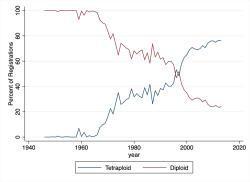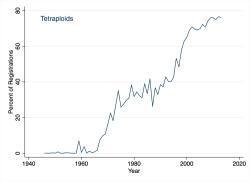I'm an early riser, routinely out in the garden before the bees and the birds.
megdavis said:
Thanks Rob!! Incredibly useful advice, I'm taking it all to heart! I may be skilled at the design of scientific experiments and data collection, management, and analysis--but I'm a total novice to daylily hybridization. Love your perspective!
admmad said:
Be aware that some daylilies start to open their flowers in the early afternoon, others in the evening and yet others during the night. There are night-flying moths and some of the daylily species were/are adapted to being naturally pollinated by night flying moths (and possibly other night flying insects) and other daylily species were/are adapted to being naturally pollinated by day flying insects. It has been noted that hand pollinations of some daylilies in the morning may never take - because the night flying insects beat the hybridizer and deposited pollen of the incorrect ploidy or self-pollinated a self-incompatible daylily. Imagine the problem if the night flying insects pollinated such daylilies and were partially successful and the hybridizer's hand pollinations were also partially successful.
I am inbreeding and line breeding. Hadn't considered five generations tho, so thanks for the tip! Is there a standard breeding approach with sibling pairs? I have specifically been acquiring some interesting parent-child registered pairs to get a jump on the line breeding.
I've sometimes used the same pollen source to pollinate the same pistil a couple of times: once in the early morning, and again later. Any data or experience on how useful that is?
admmad said:Five (or more) sometimes six generations is considered the minimum - of self-pollinations with diploids. Sibling crosses requires more generations....Tetraploids require many more generations to produce a formal inbred line.
Jillz said:Love the graph but I would think it would be more interesting to see Tets registered relative to the total registrations each year rather than the absolute numbers. (Just giving you more to do Meghan)



megdavis said:More fun data from Dennis -- this is a graph of the number of hybridizers over time by ploidy
admmad said:I can understand linebreeding in animals.
"Linebreeding is mating animals so that their descendants will be kept closely related to some animal regarded as unusually desirable. It is accomplished by using for parents animals which are both closely related to the admired ancestor but are little if at all related to each other through any other ancestors. "
"WHY LINEBREEDING IS PRACTICED
Animals do not live long enough for the breeder to get all the sons and daughters he wants from the best ones. Often an animal is old or even dead before its real superiority is recognized. If its sons and daughters are mated to unrelated individuals, the offspring will get only about one-fourth of their inheritance from this outstanding grandparent. If these in turn are mated to unrelated individuals, the influence of the outstanding ancestor is again halved. Unless some form of
linebreeding is practiced, it is only a matter of three or four generations until even the most outstanding animal's influence is so scattered and diluted that no one descendant is very much like it. Linebreeding takes advantage of the laws of probability as they affect Mendelian inheritance to hold the expected amount of inheritance from an admired ancestor at a nearly constant level instead of letting it be halved with each generation, as would happen if all the matings were outbreeding."
However, the "best ones" in a perennial plant do not ever die. In a plant such as daylilies where thousands of potential "best ones" are registered every year and cultivars can become outdated rapidly, why linebreed?
admmad said:Are the graphs of the number of hybridizers over time or are they of the number of hybridizers who registered at least one daylily in each year or ? How are years in which a hybridizer did not register any daylilies handled (gaps in their registrations)?
How were the hybridizers who registeed both tetraploids and diploids handled?
How were, the admittedly, probably quite few, hybridizers who hybridized one ploidy for a few years and then switched to the other ploidy handled?
I was planning to self-cross and line breed (backcross) to look for recessive traits
kousa said: Maurice, is there an instance where inline breeding in daylilies a good strategy?
Would you say that line breeding for broken colors help to increase the odds of getting a broken color seedling or the odds are better if the seedlings are crossed back to the striped parent?
Also, would inline breeding increase the probability of recessive genes expressions?
JamesT said:There may be quite a few hybridizers who aren't AHS members.
admmad said:@megdavis Are you going to be working with diploids primarily or tetraploids primarily or both?